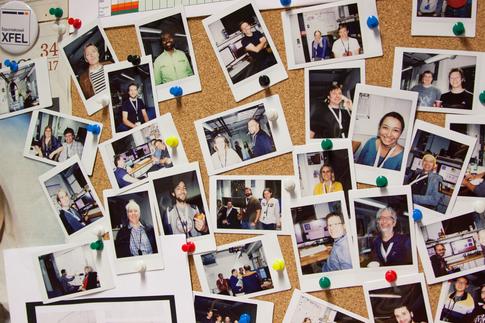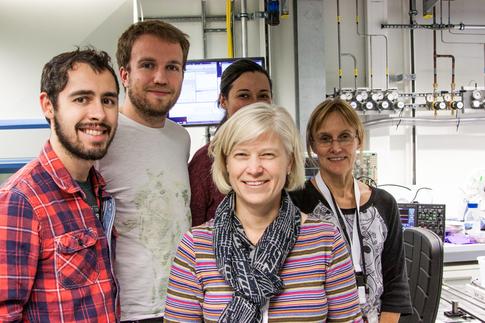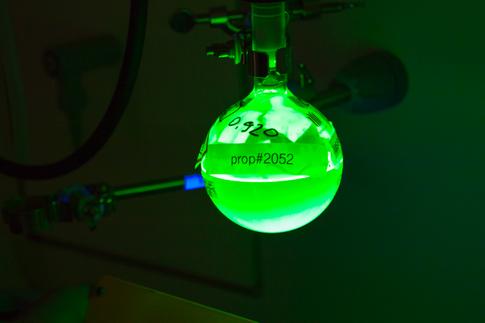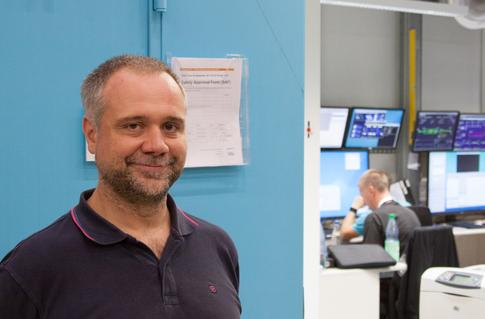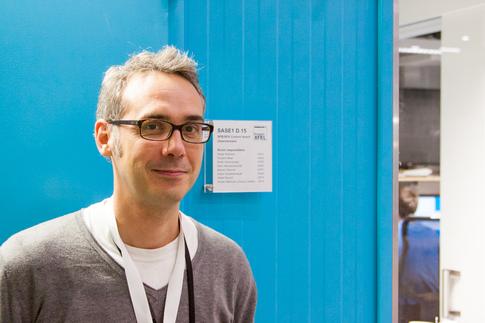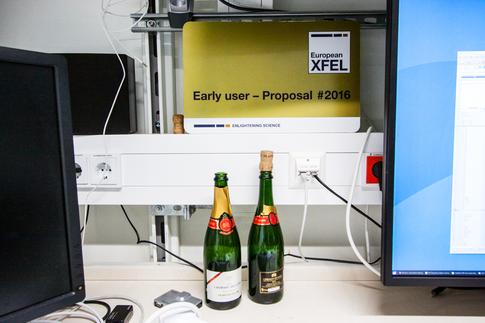XFEL: Behind the scenes at European XFEL
Behind the scenes at European XFEL
In mid-September, fourteen metres under the European XFEL building in north Germany, users started their experiments at the first two instruments to go online: the FXE Femtosecond X-Ray Experiments (FXE) instrument, and the Single Particles, Clusters, and Biomolecules and Serial Femtosecond Crystallography (SPB/SFX) instrument. But what was it like to be among the first users to ever do experiments at the facility, and how did the European XFEL staff members who supported them during their stay experience it all? We asked some for our users and staff for their impressions.
Alexandra Ros
User at the SPB/SFX instrument, Arizona State University
“During our beamtime here at European XFEL, we are doing some work on how to effectively deliver the sample into the X-ray beam at the SPB/SFX instrument. The X-ray flashes are delivered in pulse trains, so rather than produce a continuous stream of sample, meaning quite a lot of precious sample is wasted, we want to make droplets that are delivered to the beam exactly when the X-ray pulse arrives. I first came into contact with X-ray science when I joined Arizona State and I now contribute my knowledge of microfluidics to the field. We are a very interdisciplinary group, and we are also joined here by a number of other groups for this experiment – Dr. Fromme’s group, Dr. Kirian’s group and Dr. Zatsepin’s group all from Arizona State University as well as Dr. Chapman’s group from CFEL, Hamburg. Leading up to this exciting yet challenging experiment, we were sure we were going to need to troubleshoot a number of things, so we were grateful to have the support of Henry Chapman’s group at CFEL with whom we are now collaborating on instrumentation and data analysis led by Dr. Barty. The chance to be here as one of the first user groups was for us entirely exciting! I was really amazed that we got accepted! We didn’t know what to expect before coming – every day has been a steep learning process. For us, coming from the States there were the added challenges of orientation– where to sleep, where to get food, not being able to speak the language, who’s responsible for what in the facility, where are the labs – and all while being jet-lagged! There’s not that many of us here in comparison to other user groups, but we have ourselves organized into early and late shifts, and then most of us are here during the day for the beamtime. Some of us do preparation before the day shift begins, others take care of things after the experiment. We’ve done this type of experiment before at the Linac Coherent Light Source but never with a vacuum chamber. That is another level of complexity. Usually we can stand directly in front of the chamber to see what’s going on. Here we have to climb a ladder to access it! Today I really feel my muscles after four days of standing on a ladder and in uncomfortable positions! Since we need to prepare samples, we’ve been using the bio lab upstairs here and we love the sample elevator which we have been using extensively! We text our colleague in the lab at 5am – “is the sample ready yet? Please send it down now!”
"Every day has been a steep learning process."
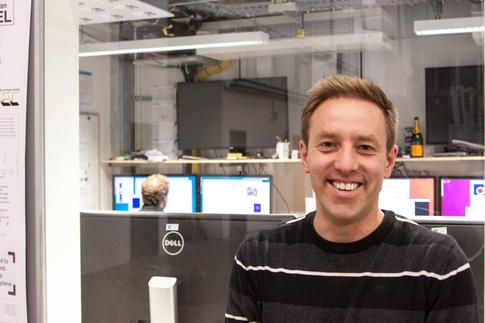
Richard Bean
SPB/SFX instrument scientist, European XFEL
“I’ve been at European XFEL for three years now, involved primarily in the design and construction of the SPB/SFX instrument. This was my first experience of being the local contact for a user group during an experiment, and that with the first ever user experiment at the SPB instrument at European XFEL. To make things even more interesting, these first users were a group of about 90 people! It felt a bit like being thrown in at the deep end, but I really enjoyed it. Over the last few years our team of scientists and engineers have been working closely together on the design, installation and commissioning of the SPB instrument so having several of the users here in the close confines of the hutch and control room for five days at a time certainly made for a different challenge! The noise levels naturally increase, and it can get easily crowded, but the atmosphere in the control room was excited and friendly. For future runs we plan to improve the communication links between the control room and analysis areas upstairs we’ve set up to make the user experience as smooth as possible. The first group were experienced free-electron laser users and had high expectations for their visit, but were also realistic about what we could achieve during the first beamtime. Of course, not everything ran smoothly and perfectly, but a lot of things did go well and I think everyone was happy with the outcome. Not only did the users have the chance to see the set-up here and get an idea of what will be possible when we are running at our full capability, but we were also able to learn from them and their suggestions. It was a great five nights, but also very intense. Once we have more of a routine going, and administrative steps are more standardized, we hope as instrument scientists we can focus on maximizing the scientific outcomes. But first, I’m looking forward to a few days holiday!”
"It was a great five nights, but also very intense."
Matthias Vogt
User at the FXE instrument, University of Bremen
“We’ve done work at the Swiss Light Source before but being here is, of course, really different. As synthetic chemists, we usually move within our own fields, but here during this experiment a relatively large group of collaborators from different institutes have come together and we have a specialist in the team for each part of the experiment and instrument. And the collaboration works really well; it’s interesting to see how that all comes together. On-site, we are responsible for the synthesis, sample preparation, and integration of the substance into the experimental setup. The substance that we are studying was developed in our laboratories at the University of Bremen. It is a strongly luminescent compound which we want to eventually develop into a material applicable in OLEDs (Organic LEDs).
OLEDs are an emerging technology when it comes to, for instance, thin and flexible digital displays and very energy-efficient illumination. They are usually based around compounds involving rare precious metals. We have discovered a chemical compound based on copper, which is cost efficient and easier to work with in comparison to other precious metal-based compounds. Also, this is one of a completely new class of compounds with unprecedented structural features, which makes this really interesting. Having the chance to work with the experts of the FXE instrumentation is particularly exciting as the ultra-fast X-ray experiments allows us, for the first time, to study the fundamental mechanism of the specific light emission in great detail, that is, the time-resolved structural and electronic dynamics during this process. We are very grateful for the outstanding support of the FXE scientists on-site; their expertise is key to the success of the experiment. I am convinced that these ultra-fast X-ray techniques will gain more and more importance in various fields of chemistry and the European XFEL will take a key position considering its high flux and femtosecond resolution."
"I am convinced that these ultra-fast X-ray techniques will gain more and more importance in various fields of chemistry..."
Andrea Cannizzo
User at the FXE instrument, University of Bern
“I think it is really unbelievable what we are trying to do here. We are interested in understanding how a toxic metal is capable of emitting light so that we can utilize it in photo voltaic systems for example. That we can experience changes in molecules, and watch them in motion is really unbelievable. Years ago I worked at DESY in the early days of PETRA III – and now I am here at European XFEL! I consider it a luxury to be here. It’s great to see how everything is working, and what challenges need to be solved, and to see everyone getting stuck into solving problems. I like rolling my sleeves up and getting hands on. That’s what I enjoy. The group currently here is made up of four groups from Switzerland, Russia, Denmark and Bremen. Next time I would like to be more active in terms of coordinating and leading a project here at European XFEL – I was not leading PI on this project, but I would like to be next time. It’s been a great opportunity to be here and see the set-up and possibilities. I see this visit as an investment for my future. It’s not a particularly health lifestyle doing these experiments – you spend a lot of time sitting, and when we do eat it is usually just something quick at strange hours, so I have really appreciated that European XFEL provides bikes for users and we can get out a bit for some exercise between shifts. It’s been nice to have seen a bit of the area!”
"I see this visit as an investment for my future."
Kristina Ivicic
User office, European XFEL
“Oh, I really love interacting with the users. They are really friendly and so thankful when you manage to solve something for them. That’s a great feeling! The users are only here for a few days, so if we don’t manage to give them the service they need, there is no tomorrow or next week. Things have to work “now”! If their samples don’t arrive in time, or their access cards won’t allow them access to the user lab, we need to fix that now, not in a few days’ time. Monday tends to be hand-over day when people arrive to prepare for upcoming experiments and start to leave at the end of their beamtime, so that’s when we get a lot of people coming in asking for information such as how do they get their access cards, where can they get something to eat, where is the room for the classroom safety training, where can they store their belongings etc. Towards the start of experiments on Thursdays things then quieten down as they settle in and focus on their science. And as the week progresses they seem to become happier and happier, leaving the experiment hall with smiles on their faces! “
"I really love interacting with the users"
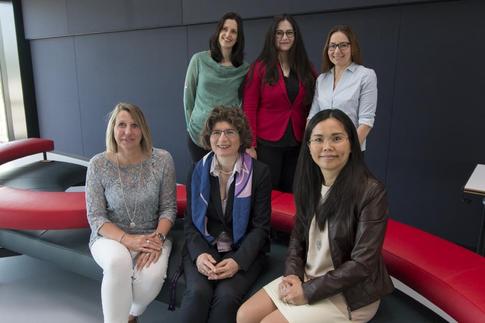
Silvia Bertini (front centre) and Kristina Ivicic (back centre) with their colleagues from the user office. ©European XFEL
Silvia Bertini
User office, European XFEL
Once the first round of user operation had finished, we could breathe a little bit and take time to make some improvements to our processes. Some things worked well, such as the travel and accommodation arrangements for the users. For many processes, the User Office acts as an interface and we have a lot of interaction with other departments like, for example, IT and Data Management for computing accounts and DESY colleagues for issues such as support about access cards and access permissions. Now, together we are working on identifying any weak links in the chain of communication and operations. The first few weeks we did a lot of learning by doing. Some systems like the safety training were operational just a few days before the first experiments, with a tremendous effort on behalf of the Safety group, but we had virtually no time for testing, so the users were the first to really test it all properly. Most users were very experienced and very friendly and happy to help, and we had very valuable feedback. We are very keen to get feedback and we very much appreciated it that they took the time to make suggestions and, if at all feasible, we will try to implement them as fast as possible. We have still plenty of work ahead of us.“
"We are very keen to get feedback..."
Pierre Aller
User at the SPB/SFX instrument, Diamond Light Source
“I work as a beamline scientist at the UK XFEL Hub alongside Allen Orville at the Diamond Light Source in the UK. Our collaboration is quite large and includes groups from the UK, USA and Germany. Here at European XFEL we are exploring ways of injecting samples into the X-ray beam for time-resolved serial crystallography experiments. It’s not as trivial as it might sound! Getting the timing right is really crucial so the X-ray beam hits the sample precisely. We are working with several different proteins including a stretch of RNA known as a riboswitch that can regulate gene activity and is interesting for gene therapy applications, as well as an enzyme called beta-lactamase which plays an important role in the resistance of Mycobacterium tuberculosis to antibiotics. Hopefully being able to watch this enzyme in action will lead to clues about how antibiotic resistance develops. We do this type of experiment by mixing the molecules together with their reaction partner so we can watch the process develop step by step in a so-called ‘molecular movie’. From crystallography experiments we know the static 3D atomic structure of the molecules before and after reaction but not what happens during the reaction itself. But really, one of the main goals of being here was to get all the collaborators together and put us in contact with each other so we can get talking about future work. That part of our visit has been a great success. In terms of our experiments, we haven’t been quite so successful but we’ve learnt a lot about the experimental set-up and also the instrument scientists have learnt a lot too about these type of experiments. Generally, we are all very excited to be here, although those who have been preparing samples are understandably a bit frustrated and disappointed when, after so much time and effort to prepare their sample, we don’t manage to use them. But that’s the way these experiments go!”
"One of the main goals of being here was to get all the collaborators together."
Wojciech Gawelda
User and beamline scientist at the FXE instrument, European XFEL
“It was very special to be invited on stage at the inauguration ceremony on the 1st September to receive our golden user card as one of the first users. Our experiment a few weeks later was the first experiment at the FXE instrument and was the first time we had used all the equipment and instrumentation to carry out a pump-probe experiment. So we were very excited, but also a bit concerned about whether everything would go well. As it turned out, everything went very well. During the first few days we managed to get a time-resolved signal from one of the samples we were working on and we also managed to test most of the instrumentation at FXE. We were studying an iron based complex in aqueous solution which can switch its magnetic properties. This was a sample we’d studied before, so we knew what was likely to happen, but it is a very interesting phenomenon with many potential applications, such as in magnetic memories or even some photovoltaic applications. We’ve been studying this for five years now as part of a large group of collaborators from three continents – it’s a mix of groups from the United States, Europe and Japan. We’ve worked together before doing preliminary experiments at other facilities in the US and Japan and we invited them to join us for this experiment. We were very pleased that our host, who took care of us and our experiment during our visits to the free-electron laser facility SACLA in Japan, could come. I think they were all very thrilled to see FXE for this first time after we’ve been telling them so much about it. After my own experiment, I was then local contact for another user group. Up to now, I’ve only been a user – now I am hosting groups of my own. It’s a completely different experience I must admit! I enjoyed it very much – although it was no longer my experiment, I tried to help others get the best out of their experiments. So the motivation is the same, but you have to concentrate on different priorities. It was very interesting, both scientifically and in terms of being a local contact, and I think it went well. We are now preparing FXE for the next round of users. We have made a number of improvements to the software, sample environment and instrument stability for example, but we are particularly excited about using our new in-house designed pump-probe laser. This laser has been designed specifically to work with the European XFEL. The pulses it produces mimic the pulses of the European XFEL. That means when there are no laser pulses from the XFEL; there are also none from the pump-probe laser, which reduces unnecessarily exposing the delicate samples to unwanted heat load. We are very interested to see how it all works.”
